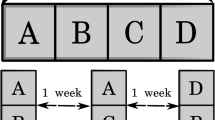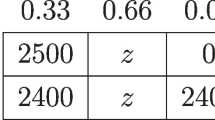Abstract
Experimental studies have discovered behavior that is inconsistent with the expected utility model (EU) of risky choice (von Neumann and Morgenstern, 1953). The two approaches to address these paradoxes are tested: generalized expected utility models (GEU) and models incorporating decision-making limits or costs through question similarity. Tests are carried out over risky pairs related to well-known examples from Kahneman and Tversky's (1979) influential work. Statistical analysis reveals that GEU models of choice are significantly violated for choice patterns consistent with the similarity hypothesis. Additional tests point to shortcomings in the similarity approach that are consistent with fanning out behavior.
Similar content being viewed by others
References
Allais, M. (1953). “Le Comportement de l'homme rationnel devant le risque: critique de postulats et axiomes de l'école américaine,”Econometrica 21, 503–546.
Azipurua, J. M., T. Ichiishi, J. Nieto, and J. R. Uriarte. (1993). “Similarity and Preferences in the Space of Simple Lotteries,”Journal of Risk and Uncertainty 6, 289–297.
Ballinger, T. P., and N. T. Wilcox. (1995). “Decisions, Error, and Heterogeneity.” Working paper, University of Houston Department of Economics.
Bernasconi, M. (1994). “Nonlinear Preference and Two-Stage Lotteries: Theories and Evidence,”Economic Journal 104, 54–70.
Buschena, D. E. (1992). “The Effects of Alternative Similarity on Choice Under Risk: Toward a Plausible Explanation of Independence Violations of the Expected Utility Model.” Doctoral disseration, University of California at Berkeley.
Camerer, C. (1989). “An Experimental Test of Several Generalized Utility Theories,”Journal of Risk and Uncertainty 2, 61–104.
Camerer, C. F., and T. H. Ho. (1991a). “Violations of the Betweenness Axiom Nonlinearity in Probability.” Working paper, University of Chicago Graduate School of Business.
Camerer, C. F., and T. H. Ho. (1991b). “Nonlinear Weighting of Probabilities and Violations of the Betweenness Axiom.” Working paper, University of Pennsylvania Department of Decision Sciences.
Chew, S. H.(1982). “A Mixture Set Axiomatization of Weighted Utility Theory.” Working paper, University of Arizona College of Business and Public Administration.
Chew, S. H. (1983). “A Generalization of the Quasilinear Mean With Applications to the Measurement of Income Inequality and Decision Theory Resolving the Allais Paradox,”Econometrica 51, 1065–1092.
Chew, S. H. (1984). “An Axiomatization of the Rank Dependent Quasilinear Mean Generalizing the Gini Mean and the Quasilinear Mean.” Working paper, Johns Hopkins University Department of Political Economy.
Chew, S. H. (1985). “From Strong Substitution to Very Weak Substitution: Mixture-Monotone Utility Theory and Semi-weighted Utility Theory.” Working paper, Johns Hopkins University Department of Political Economy.
Chew, S. H., and L. Epstein. (1989). “A Unifying Approach to Axiomatic Non-Expected Utility Theories,”Journal of Economic Theory 49, 207–240.
Chew, S. H., E. Kami, and Z. Safra. (1987). “Risk Aversion in the Theory of Expected Utility with Rank-Dependent Probabilities,”Journal of Economic Theory 42, 370–381.
Chew, S. H., and K. R. MacCrimmon. (1979). “Alpha-Nu Choice Theory: A Generalization of Expected Utility Theory.” Paper No. 82-4, Faculty of Commerce and Business Administration Discussion, University of British Columbia.
Conlisk, J. (1989). “Three Variants on the Allais Example,”American Economic Review 79, 392–407.
Davison, M. L. (1983).Multidimensional Scaling. New York: John Wiley & Sons.
Debreu, G. (1960). Review of “Individual Choice Behavior: A Theoretical Analysis,” by R. D.Luce. American Economic Review L, 186–188.
Dekel, E. (1986). “An Axiomatic Characterization of Preferences Under Uncertainty Weakening the Independence Axiom,”Journal of Economic Theory 40, 304–318.
Fishburn, P. C. (1981). “An Axiomatic Characterization of Skew-Symmetric Bilinear Functionals, With Applications to Expected Utility Theory,”Economics Letters 8, 311–313.
Fishburn, P. C. (1983). “Transitive Measurable Utility,”Journal of Economic Theory 31, 293–317.
Fishburn, P. C. (1988).Nonlinear Preference and Utility Theory. Baltimore, MD: Johns Hopkins University Press.
Gul, F. (1991). “A Theory of Disappointment Aversion,”Econometrica 59, 667–686.
Harless, D. (1992). “Predictions About Indifference Curves Inside the Unit Triangle: A Test of Variations in Expected Utility Theory,”Journal of Economic Behavior and Organization 18, 391–414.
Harless, D. (1993). “Experimental Tests of Prospective Reference Theory,”Economics Letters 43, 71–76.
Harless, D., and C. F. Camerer. (1994). “The Predictive Utility of Generalized Expected Utility Theory,”Econometrica 52, 1251–1289.
Hey, J. D., and C. Orme. (1994). “Investigating Generalizations of Expected Utility Theory Using Experimental Data,”Econometrica 62, 1291–1326.
Jensen, N. E. (1967). “An Introduction to Bernoullian Utility Theory: I. Utility Functions,”Swedish Journal of Economics 69, 163–183.
Kahneman, D., and A. Tversky. (1979). “Prospect Theory: An Analysis of Decision Under Risk,”Econometrica 47, 263–291.
Krantz, D. H. (1967). “Rational Distance Functions for Multidimensional Scaling,”Journal of Mathematical Psycholog: 4, 226–245.
Krumhansel, C. L. (1978). “Concerning the Applicability of Geometric Models to Similarity Data: The Interrelationship Between Similarity and Spatial Density,”Psychological Review 85, 445–463.
Leland, J. W. (1990). “A Theory of Approximate Expected Utility Maximization.” Working paper, Carnegie Mellon University Department of Social and Decision Sciences.
Leland, J. W. (1992a). “Choice Paradoxes as Decision Errors.” Working paper, Carnegie Mellon University Department of Social and Decision Sciences.
Leland, J. W. (1992b). “Generalized Similarity Judgments.” Working paper, Carnegie Mellon Univrsity Department of Social and Decision Sciences.
Leland, J. W. (1992c). “Similarity Judgments, Intransitivities and the Preference Reversal Phenomenon.” Working paper, Carnegie Mellon University Department of Social Decision Sciences.
Luce, R. D. (1956). “Semi-Orders and a Theory of Utility Discrimination,”Econometrica 24, 178–191.
Luce, R. D. (1961). “A Choice Theory Analysis of Similarity Judgments,”Psychometrika 26, 151–163.
Luce, R. D., and P. C. Fishburn. (1990). “Rank- and Sign-Dependent Linear Utility Models for Finite First-Order Gambles,”Journal of Risk and Uncertainty 3, 29–59.
MacCrimmon, K. R., and S. Larsson. (1979). “Utility Theory: Axioms Versus “Paradoxes'.” In Maurice Allais and Ole Hagen (eds.),Expected Utility Hypothesis and the Allais Paradox. Dordrecht: D. Reidel Publishing Co.
Machina, M. J. (1982). “Expected Utility Without the Independence Axiom,”Econometrica 50, 227–323.
Machina, M. J. (1983). “The Economic Theory of Individual Behavior Toward Risk: Theory, Evidence and New Directions.” Technical Report No. 433, Center for Research on Organizational Efficiency, Stanford University.
March, J. G. (1978). “Bounded Rationality, Ambiguity and the Engineering of Choice,”Bell Journal of Economics 9, 587–608.
Marshack, J. (1950). “Rational Behavior, Uncertain Prospects, and Measurable Utility,”Econometrica 18, 11–41. Errata, 1950, p. 312.
Mellers, B. S., and M. H. Birnbaum. (1982). “Loci of Contextual Effects in Judgement,”Journal of Experimental Psychology 8, 582–601.
Nakamura, Y. (1984). “Nonlinear Measurable Utility Analysis.” Doctoral dissertation, University of California at Davis.
Nakamura, Y. (1985). “Weighted Linear Utility.” Working paper, Osaka University Department of Precision Engineering.
Neilson, W. S. (1992). “A Mixed Fan Hypothesis and Its Implications for Behavior Towards Risk,”Journal of Economic Behavior and Organization 19, 197–212.
Parducci, A., and L. R. Perrett. (1971). “Category Rating Scales: Effects of Relative Spacing and Frequency of Stimulus Values,”Journal of Experimental Psychology Monograph 89, 427–452.
Payne, J. W., J. R. Bettman, and E. J. Johnson. (1988). “Adaptive Strategy Selection in Decision Making,”Journal of Experimental Psychology, Memory and Cognition 14, 534–552.
Quiggin, J. (1982). “A Theory of Anticipated Utility,”Journal of Economic Behavior and Organization 3, 323–343.
Quiggin, J. (1985). “Anticipated Utility, Subjectively Weighted Utility and the Allais Paradox,”Organizational Behavior and Human Decision Processes 32, 94–101.
Quiggin, J. (1987). “Decision Weights in Anticipated Utility Theory: Response to Segal,”Journal of Economic Behavior and Organization 8, 641–645.
Restle, F. (1961).Psychology of Judgment and Choice. New York: John Wiley & Sons.
Rubinstein, A. (1988). “Similarity and Decision Making Under Risk: Is There a Utility Theory Resolution to the Allais Paradox?”Journal of Economic Theory 46, 145–153.
Rumelhart, D. L., and J. G. Greeno. (1971). “Similarity Between Stimuli: An Experimental Test of the Luce and Restle Choice Models,”Journal of Mathematical Psychology 8, 370–381.
Russo, J. E., and B. A. Dosher. (1983). “Strategies for Multiattribute Binary Choice, “Journal of Experimental Psychology 9, 676–696.
Segal, U. (1984). “Nonlinear Decision Weights With the Independence Axiom.” Working paper No. 353, University of California at Los Angeles Department of Economics.
Segal, U. (1987). “The Ellsberg Paradox and Risk Aversion: An Anticipated Utility Approach,”International Economic Review 28, 175–202.
Shepard, R. N. (1964). “Attention and the Metric Structure of the Stimulus Space,”Journal of Mathematical Psychology 1, 54–87.
Shepard, R. N. (1974). “Representation of Structure in Similarity Data: Problems and Prospects,”Psychometrika 39, 373–421.
Simon, H. A. (1960).The New Science of Management Decision. New York: Harper and Brothers.
Smith, V. L., and James M. Walker. (1993). “Monetary Rewards and Decision Cost in Experimental Economics,”Economic Inquiry 31, 245–261.
Sopher, B., and G. Gigliotti. (1993). “Intransitive Cycles: Rational Choice or Random Error? An Answer Based on Estimation of Error with Experimental Data,”Theory and Decision 35, 311–336.
Starmer, C. (1992). “Testing New Theories of Choice Under Uncertainty Using the Common Consequence Effect,”Review of Economic Studies 59, 813–830.
Starmer, C., and R. Sugden. (1987). “Violations of the Independence Axiom: An Experimental Test of Some Competing Hypotheses.” Discussion Paper No. 24, University of East Anglia Economics Research Centre.
Tversky, A. (1972). “Elimination by Aspects: A Theory of Choice,”Psychological Review 79, 281–299.
Tversky, A. (1977). “Features of Similarity,”Psychological Review 84, 327–353.
Tversky, A., and D. Kahneman. (1992). “Advances in Prospect Theory: Cumulative Representation of Uncertainty,”Journal of Risk and Uncertainty 5, 297–323.
Tversky, A., and J. E. Russo. (1969). “Substitutability and Similarity in Binary Choice,”Journal of Mathematical Psychology 6, 1–12.
Viscusi, W. K. (1989). “Prospective Reference Theory: Toward an Explanation of the Paradoxes,”Journal of Risk and Uncertainty 2, 235–264.
von Neumann, J., and O. Morgenstern. (1953).Theory of Games and Economic Behavior, 3rd ed. Princeton, NJ: Princeton University Press.
Wilcox, N. T. (1993). “Lottery Choice: Incentives, Complexity and Decision Time,”Economic Journal 103, 1397–1417.
Wu, G. (1994). “An Empirical Test of Ordinal Independence,”Journal of Risk and Uncertainty 9, 39–60.
Yaari, M. (1987). “The Dual Theory of Choice Under Risk,”Econometrica 55, 95–115.
Author information
Authors and Affiliations
Rights and permissions
About this article
Cite this article
Buschena, D., Zilberman, D. Performance of the similarity hypothesis relative to existing models of risky choice. J Risk Uncertainty 11, 233–262 (1995). https://doi.org/10.1007/BF01207788
Issue Date:
DOI: https://doi.org/10.1007/BF01207788




